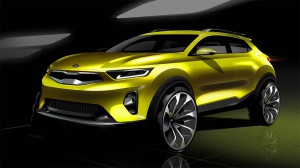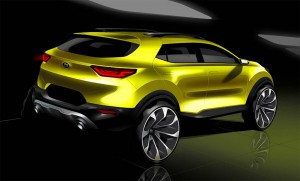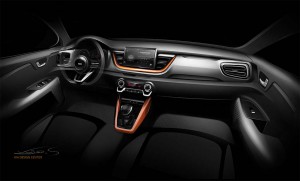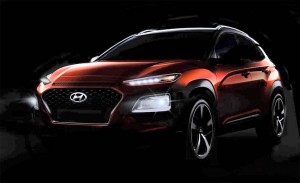Even before we had a chance to check out the three renderings of Kia’s new subcompact crossover, the Korean carmaker’s press release got our minds working overtime. What exactly is a “Stonic”? What could it be trying to convey with that curious name – and how might it resonate with consumers.
“Strong” and “Supersonic,” perhaps, or “Speedy” and “Bionic”? Well, we were getting warm. The name actually blends the words “Speedy” and “Tonic,” it turns out. And, if nothing else, we’re betting Kia’s legal team likes it because it’s likely not going to conflict with any existing trademarks anywhere in the world.
The Kia Stonic appears to be the smaller Korean carmaker’s answer to bigger sibling Hyundai’s new Kona – of which we got a pair of teaser images just a few days ago. Both models are believed to share the same, underlying platform as the redesigned Hyundai Accent coming out later this year.
(Click Here for a first drive of the new Kia Soul EV.)
here the bigger brand delivered two actual photographs to our inbox, Kia is only offering three renderings of the new Stonic – though that package includes a look at the CUV’s interior. We’ll have to wait to get a look at the Kona’s cabin.
The basic hardpoints, including the location and rake of the steering wheel and the basic platform layout, are common between both Korean models. The running lamps and headlights of the Kia Stonic are far less exaggerated, however, though the split layout is common – with both reminding us, a bit, of the Jeep Cherokee.
If these teaser sketches are accurate to the production models, Kia is opting for a relatively chopped-looking greenhouse, the roofline tapering back a bit as it flows towards a roof-mounted spoiler. The graphics of the taillights, meanwhile “amplify Stonic’s young and futuristic appearance,” Kia’s press release suggests.
The release also highlights a “sweeping roofline,” vaguely reminiscent of the Range Rover Evoq. Add aht is dubs a “uniquely designed roof rack.”
In silhouette, the Kia Tonic has some sculptural details, such as the sharp-edged wheel arches and the feature line running midway through the doors, but it is far less of an exaggerated look than that of the Kona.
We’ll have to see what carries over into the production model. We’d expect somewhat smaller tires than we see here filling the wheel wells. Will Kia carry over the distinctive, flush door handles? Most likely, the 2018 Kia Stonic will feature the new take on the brand’s familiar “tiger nose” grille, however.
“The European-designed cabin echoes the appearance of the exterior, with straight lines, smooth surfaces and geometric design forms,” says the carmaker. “The Stonic’s interior places technology and ergonomics at its heart, with smart packaging maximising space for all occupants, and a ‘floating’ HMI (human-machine interface) seamlessly blending smartphone access with the car’s many functions.”
One of the more interesting tidbits found in the release is the promise that the Stonic “will be the most customizable Kia ever, inside and out.”
(Click Here for a first look at the upcoming 2018 Hyundai Kona.)
(A number of questions have been left unanswered, among them: what powertrain or powertrains will Kia opt for. We’re expecting something similar to what will show up in the Hyundai Kona. The current Accent, which shares underpinnings, motivated by a 1.6-liter inline-four in U.S. trim. We might see a somewhat heavier CUV get a bit more boost, perhaps Kia’s 2.0-liter alternative. Look for a more options, including diesels, in other markets.
The decision to go after the subcompact ute segment next is no surprise for either manufacturer. Globally, it is one of the fastest-growing market niches and has been gaining traction in the U.S. rapidly. We’ve seen all of the major Japanese makers get into the game. Jeep recently came onboard with the Renegade and Ford has its own model coming, the American version of the EcoSport making its debut at the Los Angeles Auto Show last November.
We should learn more about the Kia Stonic even before its official launch which, the carmaker says, will be during “the second half of 2017.”
(Toyota could take to the air for the 2020 Olympics. Click Here for the full story.)




